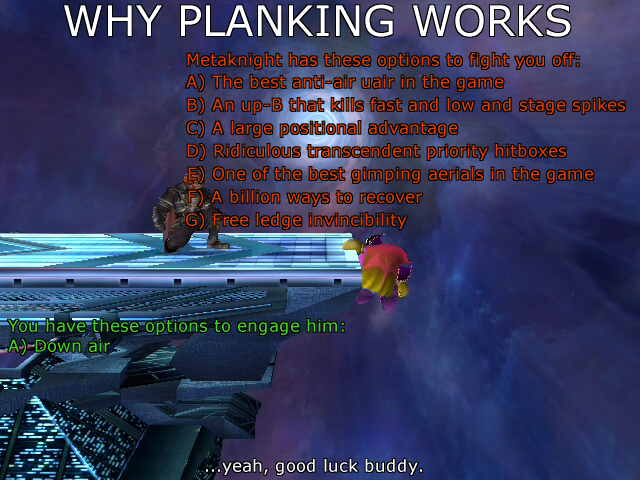Raziek
Charging Limit All Day
Lava and You: A Marth's Guide to Norfair

Welcome to Norfair!

Welcome to Norfair!
Norfair has most recently come into play as one of the new counter-picks to be added to the MLG stage list. Not conventionally legal, this stage has a lot of controversy surrounding it. This guide is meant to serve as a tool for Marths to learn HOW this stage works, and how to use it against our opponents as efficiently and effectively as possible.
Warning: This guide is picture-heavy.
General Features
Blast Zones
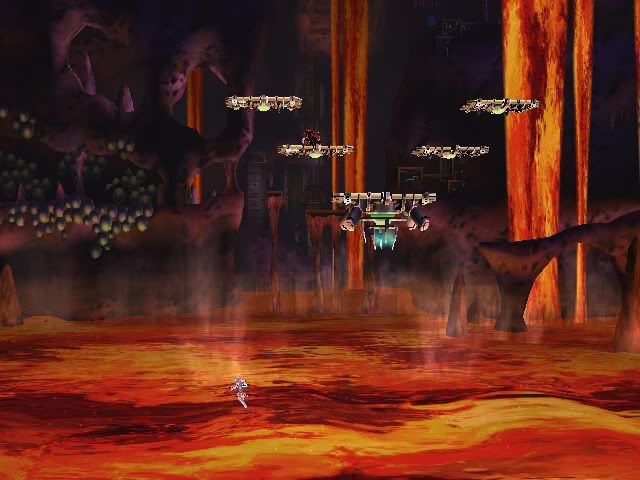
The bottom blast zone for Norfair is quite deep, but this is not necessarily a bad thing. As we know, Marth possess an exceptional vertical recovery. Using his double jump, a DB stall, and DS, Marth IS capable of recovering to the bottom platform from the very bottom of the stage.
Norfair plays nicely with our recovery, and the only time you should ever be gimped is if you happen to DI downwards and end up outside of the horizontal distance required to reach the bottom platform. Vertical distance should play little issue.
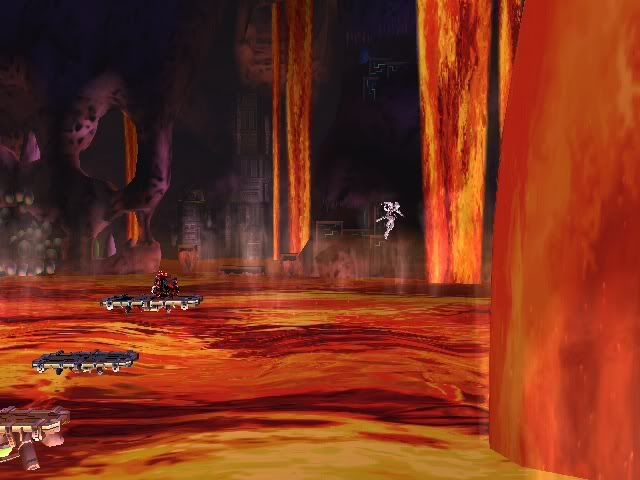

The left and right blast-zones are of course, equally sized, and are actually larger than they appear in game. From my experience, the ceiling does not appear to curve towards the outside, and is actually closer to a square shape. I have survived to as high as 200% by DI'ing towards the corners. The ceiling itself is rather low, but the corners allow you some leeway.
Because of the size of the blast zones, it IS possible to grab early DS kills by fairing the opponent offstage, then DS'ing close to the ledge. If the Lava floor has risen, you can net an unexpected, early kill, and the floor will save you for a meager 14% damage.
Platforms
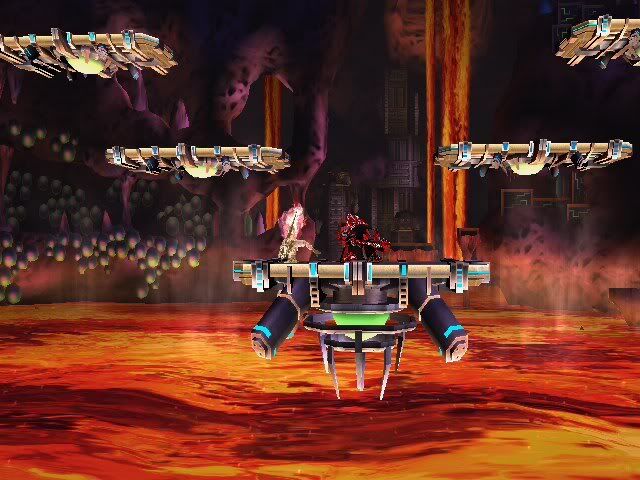
Norfair's platforms are an interesting bunch. Norfair is comprised of three tiers of platforms: The bottom-most (center) platform, and two tiers of higher platforms, spaced equally in height and width from each other. (The stage is symmetrical) They are spaced such that a ledge-dropped double-jump allows quick and easy travel between the three ledges.
Norfair's bottom platform is semi-permeable. It can be passed through from below, but not through the green orb's structure. That structure is solid, meaning you can tech it, be stage-spiked off of it, and interact with it as you would a normal stage bottom. However, it CAN be passed through in the small space to the left and right of it.
Note: As seen in the picture above, if Dolphin Slash does not pass COMPLETELY through the bottom platform, you will fall through and die. (like Delfino) Fortunately, the edge snap is rather lenient, and holding backwards will allow you to grab the edge behind you.
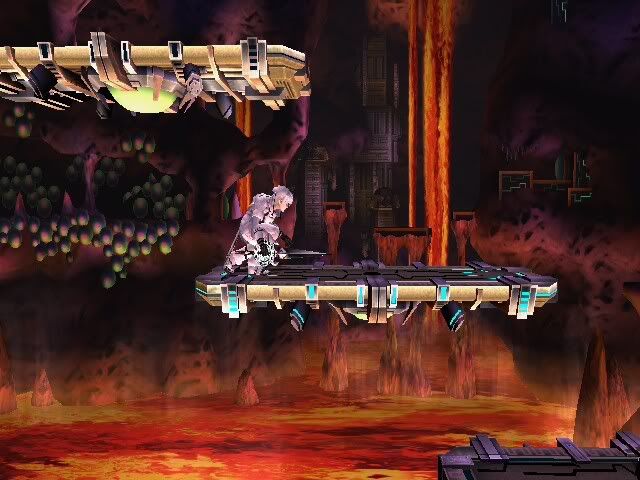
The second and third tier of platforms are permeable, so you can fast-fall through them from above, and jump through from below without obstruction. However, there is one IMPORTANT catch with these platforms. They cannot be passed through by the edge that is grab-able. (As seen in the picture above) Take care doing d-tilts on the second and third tier of platforms, as it is easy to do a fall-through dair by mistake.
Next we'll move on to examining the different stage hazards that are present on Norfair. First up...
The Lava Floor
The first thing to know about Norfair's Lava Floor is that it rises to THREE different heights.
The first level can be seen two pictures up, where the lava rises to just below the bottom platform. This is one of the more common heights for it to be, and the lava will provide a net that will save you from the bottom blastzone. (Note: If spiked hard enough, you CAN be sent through it to your death.)
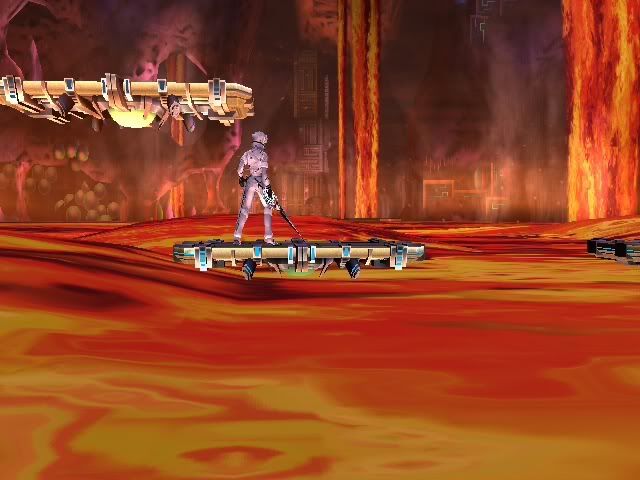
The second level (seen above), rises to completely cover the bottom platform. The second tier of platforms CAN be stood on safely, but be aware that the lava "flows" slightly, and parts of the second level occasionally become submerged in the lava for a brief period of time. This does not always cover the entire platform.
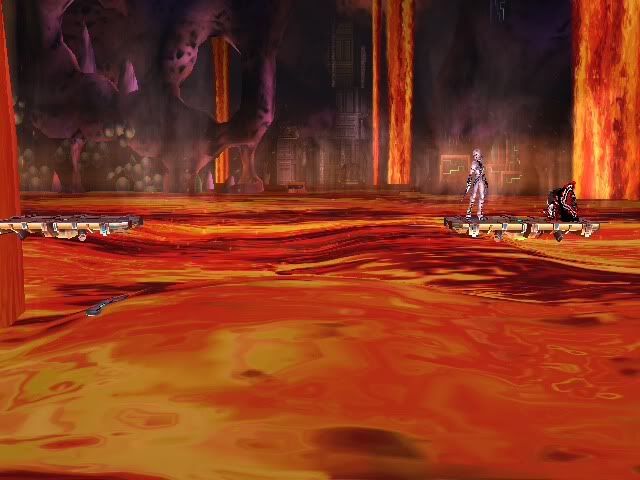
The third level (seen above), covers the bottom and second tier of platforms completely, and DOES NOT become exposed from the flow. The third platforms are completely safe in this scenario, and though the lava does flow, it will never cover the third tier.
Damage and Kill Information
The Lava Floor is the least dangerous of Norfair's hazards, and the most common. it does 14% per hit, and does not diminish in damage or knockback. However, the lava will not actually kill Marth until a very high percent.
It is survivable from the bottom platform up to 158%, with no DI. This number will vary slightly depending on what height you fall into it, and depending on your DI.
This transition is fairly benign, but can be turned to our advantage. When the lava rises to the third level, this will often force a separation of the players, with each taking a platform. However, if you are feeling aggressive, or the Lava Wall comes in from one side, take advantage of the situation by forcing your opponent INTO the lava by whatever means possible. Our aerials (sans Dair) are particularly effective at controlling space, and thanks to our maneuverability, forcing our opponents into the lava for combos is easy and effective.
Next hazard on our list:
The Lava Wall

Periodically during the match, a vertical lava wall will come in from one side of the screen. This can occur on a 30 second timer (as explained at the bottom of the guide), sharing this "hazard clock" with the lava plumes. The wall will always move up to exactly the center of the stage, effectively dividing it in two. The screen will zoom out and focus on the side that the wall will be coming from, so if you notice it zoom out, take it as your cue to get on the opposite side of the screen, ready to force your opponent into the wall.
Note: This transition often occurs in conjunction with the Lava Floor rising, severely restricting the space available for play. Be prepared and take advantage of it.
Damage and Kill Information
The Lava Wall is one of the more dangerous hazards on Norfair. It does 14% when knocked into it, with moderate horizontal knockback in the opposite direction of the wall. This is survivable up to around 150%, though this seems to be somewhat affected by momentum, and can be DI'd.
It IS possible to power-shield the lava and roll to safety. As well, you can also air-dodge into it. (this can save you in a pinch, since you'll take the hit closer to the far side of the stage)
Make sure to take advantage of this transition as much as possible. Stay on the ledges and use retreating bair or fair to play wall-ball with your opponent. If they are unprepared, this is a great transition to rack up damage. If they begin to adapt to shielding your aerials, feel free to throw them into the wall for easy damage.
The Lava Geysers


Every 30 seconds, up to three (possibly four) geysers of lava can shoot up from the lava in the rear of the screen. Their appearance is preceded by the screen shaking (though the shaking does not ALWAYS mean they will come), and they will follow a few seconds later. They will arc in a straight line onto the stage, damaging anything in their path. These are extremely random in placement and number, but can occasionally net you some extra damage, and early kill, or some shield pressure.
Should you decide to deal with one by shielding it, wait until it contacts once, then let down your shield and MOVE. While the hitbox is active the entire time, my testing has indicated that there is a set period of time before the lava can hit you again, giving you time to move. If you choose to shield two hits there is a SEVERE risk of breaking your shield. Fortunately for us, this works both ways. If your opponent shields a hit, go for the break. You'll almost certainly land it, then you've earned a free kill, and the Geyser may even finish them off FOR you.
Note: The Geysers often arrive while the Lava Floor has risen, limiting the space available to maneuver.
Damage and Kill Information
The Lava Geysers are the most dangerous hazard on Norfair, despite dealing the least damage. They only do 10% damage, but they pack one HELL of a punch. Depending on where you get hit, these can kill you as early as 80%, and are somewhat difficult to DI. Be prepared to avoid them, and should the opportunity present itself, take advantage of the shield pressure they can put on your opponent.
Finally, our last hazard:
The Lava Wave

Just before the Lava Wave occurs, the "Safety hut" will appear on a random platform, with its doors shut. (Note: This slightly widens the platform it appears on) The safety hut's doors will open when struck by any attack. It's also worth nothing that the safety hut CAN be teched against. (Thanks to FeSoren for this tip) After the hut emerges, the Wave will spring up in the background, and begin rushing towards the screen.
At this point, you have two options.
- Rush for the Safety Hut
- Avoid the Wave
Rushing for the safety hut is an extremely bad idea. Should you even manage to make it in, you'll be trapped in there for a few seconds following the wave, and some opponents will be able to hit you from the outside, through the walls. Since we have disjointed attacks, this is what WE want to do. Let your opponent take the hut if they choose to, and if they do, poke them with Fair, Bair, U-smash, F-smash, or anything else sufficiently disjointed and punish them for their really bad idea.
Note: If the Safety Hut appears on the second or top tier of platforms, once the walls are up, there will not be enough standing room to stay on the platform, so you MAY get hit if you try to shield on the same platform as the hut.
Option 2 is clearly the best, and there are several means by which we can avoid the wave.
- Spot-dodge
- Shield
- Go over it
- Use Invincibility Frames
Shielding is by far the safest option. The shield damage is negligible, and there is only mild shield-stun. You CANNOT be hit by the wave if you shield, even the tiniest spec remaining will protect you. (Though it may break.)
Spot-dodging is risky, since you can be hit if you miss-time it. Going over it is a reasonable option. From the top platform, you can jump over it using only our two jumps, and you can Dolphin Slash if you need to for that little bit of extra height, though you risk leaving yourself vulnerable if your opponent is nearby.
The most bad-*** option we have is to time a Dolphin Slash JUST right so that the wave passes by during our invincibility frames. I've successfully done this a few times, but the timing is very strict and is quite unsafe. Reserve this option for those "HUMILIATION!" moments.
Damage and Kill Information
The Lava Wave is probably the second-most dangerous hazard on the stage, if only because it is easy to avoid, unlike the Geysers. The wave itself does 16% and has high knock-back. Without DI, this will kill Marth at 80% (Bottom Platform), 70% (Second tier) or 60% (Top Tier), so make sure you DO NOT GET HIT BY THIS.
This transition presents a great Risk vs. Reward situation. You can choose to camp it out and play safe, or you can rush your opponent in an attempt to poke them while they try to defend, possibly forcing an early kill or a shield-break. If you're feeling ballsy, try to hit them with an auto-canceled aerial into shield, right as the wave arrives.
Another interesting feature for the stage, pointed out by BengalsRZ:
Also note that this port priority trick works for ALL of Norfair's hazards.BengalsRZ said:If you have a higher port than the other person (i.e you are p4 and the other guy is p1), when the huge lava wave comes (the one where the hut appears) try to get the grab. It kills pretty early and you won't eat any knockback, but you'll take 16%. Definitely worth it in most cases. If it doesn't kill your opponent it'll bring him to the top and put him in a bad position which you can abuse.
NEW NORFAIR AT: Counter Stalling
Thanks to some discussion and testing between myself, Swordgard, and Syko_Lemming, I have refined and put together a new AT for Marth specifically for use on Norfair, which I have decided to call Counter Stalling.
The basic premise of the AT is to abuse the invincibility frames from counter, in combination with the power-shield and the grace period provided by the lava, to stall indefinitely inside ANY of Norfair's hazards.
I've put together a short instructional video on the AT which can be found HERE
Also included in the video is a quick demonstration of a Marth technique that is applicable on multiple stages, one of which is Norfair. If you buffer a dair out of a full hop, it should auto-cancel on the platform, eliminating the majority of the landing lag.
General Tips & Play-style Overview
Playing on Norfair will often revolve around controlling the bottom, central platform. From here, you can easily apply pressure on your opponent through retreating aerials, and attacks from underneath the platforms.
Fortunately, the bottom platform is semi-permeable, so make good use of D-tilt to force your opponents onto the ledge, and use your throws and aerials to KEEP THEM OFF THE GROUND. If they manage to set up camp in the middle, you will have a really hard time getting back in. Should this happen, retreat to the top platform until the stage throws a hazard out to displace them. Geysers, the Wall, and the Floor can all quickly force them out, and if they try to stay nearby, combo them off of the hazards. Once the hazards are gone, use your superior speed to quickly reclaim the center and resume pressure.
The goal is to force them onto the second or third tier platforms, then kill them early with an aerial from a safe distance. Tipped Nair can kill as early as 65% on some characters if you can force them onto the edge of the third tier platform. Bair and Uair are also extremely good kills on this stage, allowing you to attack safely (by retreating bair), and through quick vertical kills. (uair) be mindful of characters like Snake who will throw out attacks to trade with these. U-tilt can kill you extremely early if you get greedy and space poorly on a kill attempt.
Abusing the Platforms
Marth has a LOAD of options to abuse the platforms on this stage. His long disjoints allow him to hit our enemies from a safe distance while still effectively controlling space. Marth can stand under the opponent on the tier of platforms below, and remain completely safe.

From this position, Marth can retaliate with a number of attacks, including:
Jab
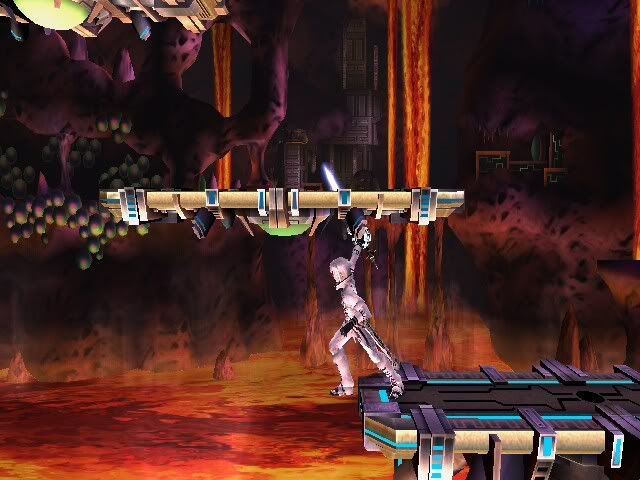
U-tilt
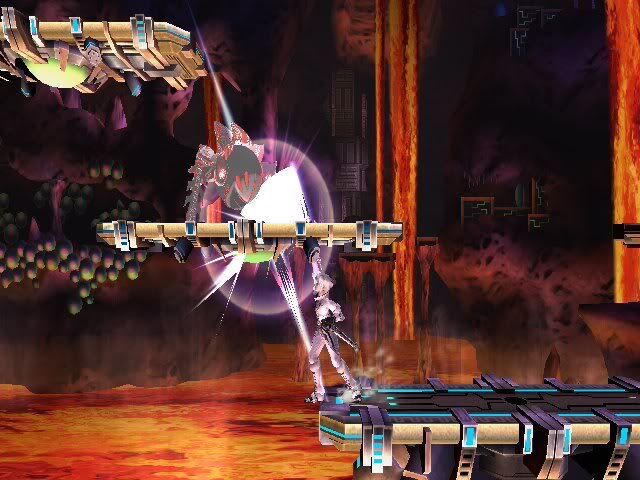
F-tilt

F-smash
Note: This is tough to land, but it always tippers.
Note: This is tough to land, but it always tippers.
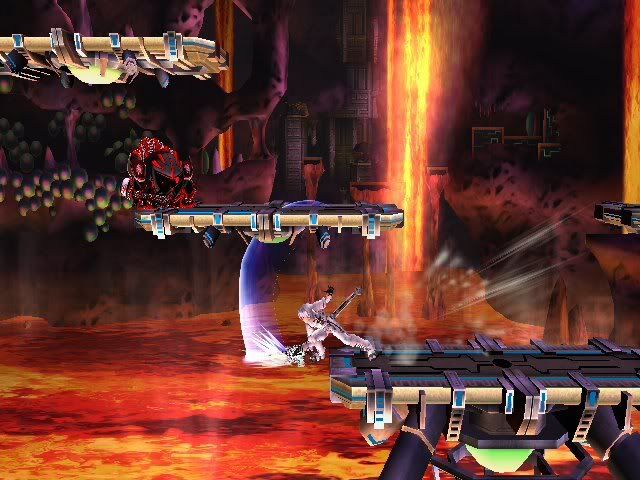
U-smash
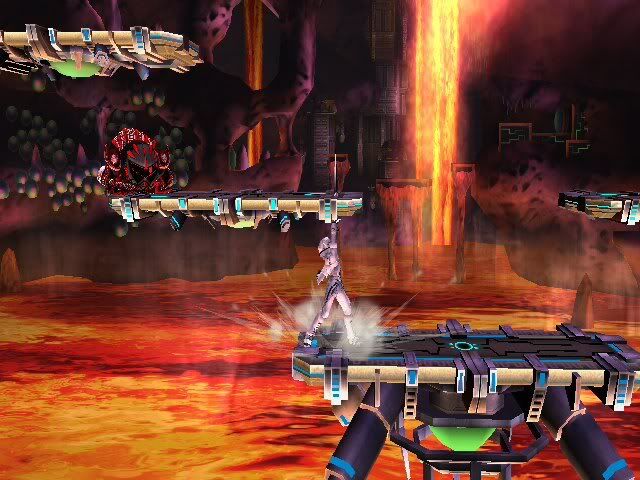
Our options for controlling space using our aerials are even better. If our opponent is on one of the upper tiers, we can use:
Bair
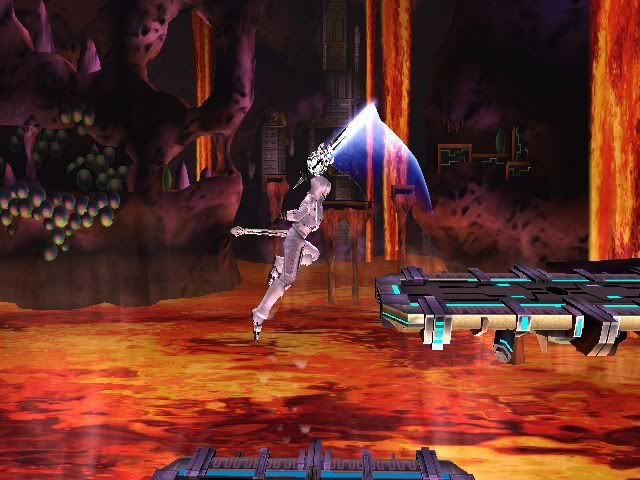
Fair
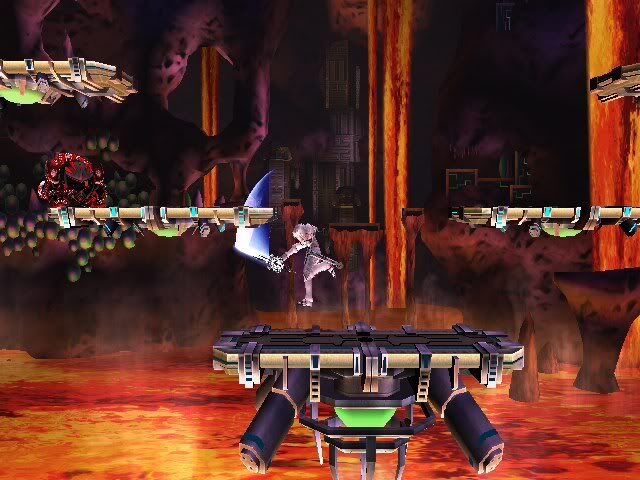
Nair
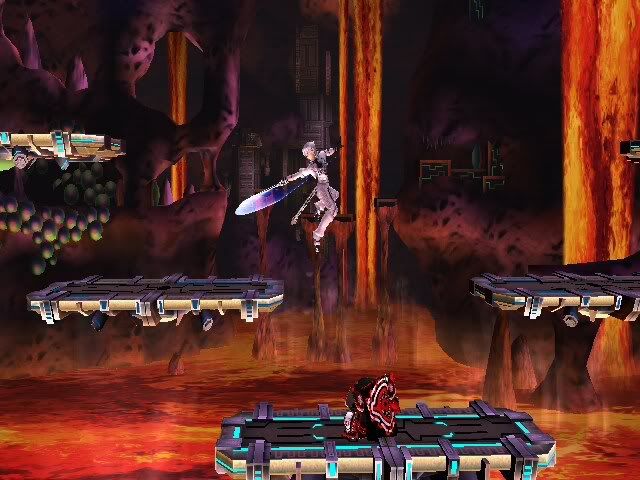
BACKWARDS Nair
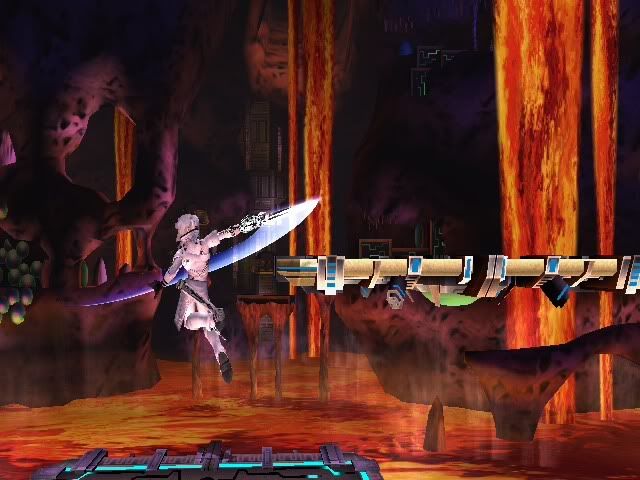
Uair
Note: This is riskier, as it exposes Marth's hurtbox more.
Note: This is riskier, as it exposes Marth's hurtbox more.
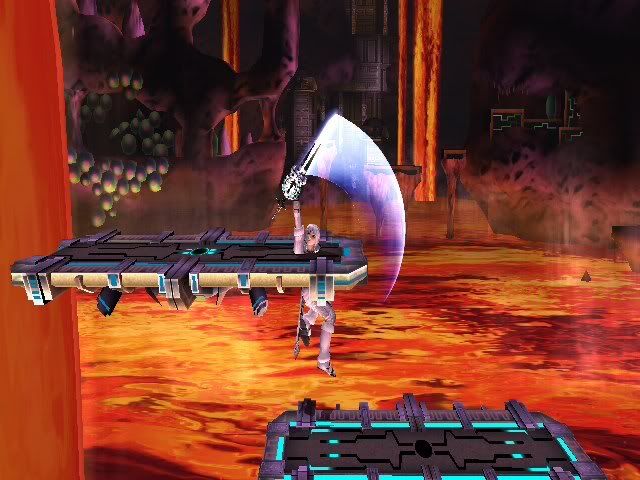
Shield-breaker

The key to winning on Norfair is to control your space effectively, and force your opponents to deal with the stage. If you are playing correctly, you should RARELY be hit by Norfair's hazards, and your opponents will feel like they lost to the stage, not to you.
Important: Norfair is NOT RANDOM
According to some recent trials done by Judo777, Norfair is NOT as random as initially thought.
So, the gist of how this works is:Judo777 said:(Some editing done for spelling n' such)
On Norfair every 30 seconds the stage will tell you what is about to happen. At about 7:30 (sec) into the match 1 of 3 things will happen. Either the screen will pan out to 1 side which will indicate that the lava wall will appear on that side in about 10 seconds, or you will see the screen start to shake, letting you know that lava plumes will be coming in about a second. However the last option is that nothing can happen at 7:30. (sec) However, if nothing happens at that time then nothing will continue to happen until 7:00 (sec).
Let me expound on each of these further. The lava plumes actually hit generally 5 seconds after the 30 second mark so actually at 35 seconds. However the screen should shake around the 30 second mark letting you know they are coming. The screen can however shake without sending lava plumes however its still a good heads up. However where the lava plumes hit and how many show up are in fact random.
The only thing that appears to mess this up a little is that when the giant lava wave comes up because (like i said earlier) that is completely random it appears that the second clock can be shifted by about 10 seconds. however all i ever noticed was a shift of no greater than 10 seconds from where it last was in reference to the 30 second interval.
- The Lava Plumes and the Lava Wall operate on 30 second intervals.
- The screen will shake prior to the arrival of the lava plumes.
- The Lava Wave CANNOT occur while the plumes or wall is active, and only if the floor is BELOW stage level.
- The Lava Wave seems to shift the "hazard clock" by about 10 seconds.
So, there we have it. Norfair isn't even as random as we once thought.

